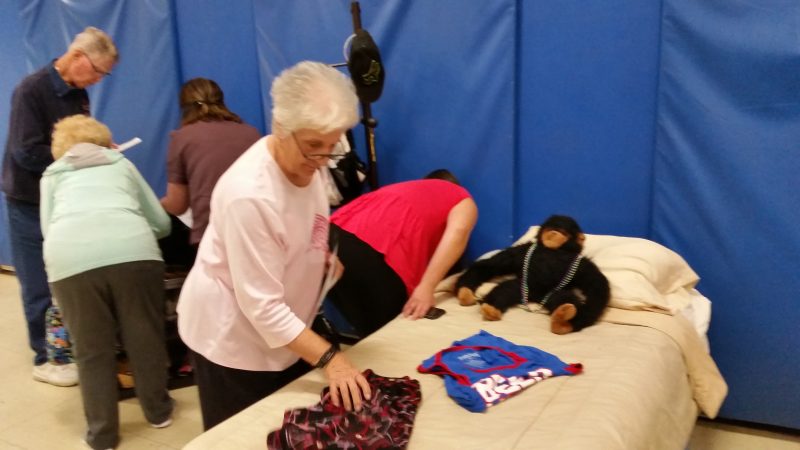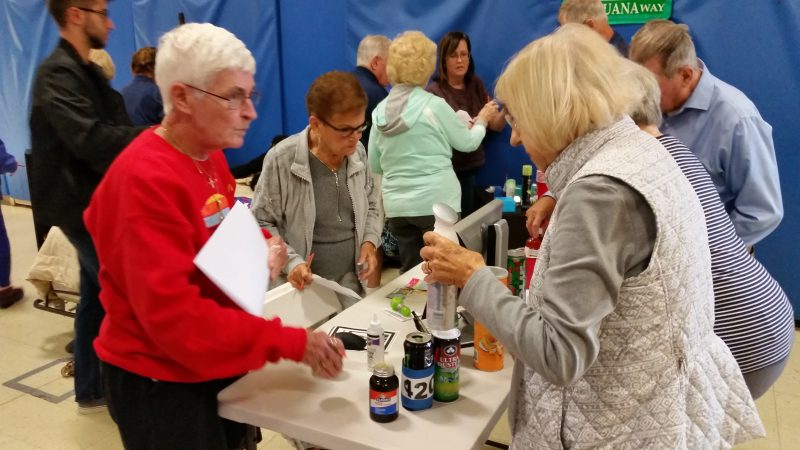"It can happen to anyone," speaker Melissa Niles warned the audience of the possibility of drug or alcohol abuse.
 By Donald Wittkowski
Monica Santarcangelo and other senior citizens took turns Thursday walking through a section of the Sea Isle City Public School gymnasium that had been transformed to look like a teenager’s bedroom.
Scattered throughout the room were seemingly innocuous things that most teens typically would have – a stuffed animal on the bed, soda cans on a table, jewelry boxes on the dresser and piles of clothing and shoes on the floor.
But the 79-year-old Santarcangelo, a Sea Isle resident, took a closer look at some of the items. When she opened a lipstick case to inspect it, she gasped.
“Oh my God. Do you see that?” she said in amazement.
The lipstick case doubled as a hiding place for drug paraphernalia. In fact, there were more than 50 places in the simulated bedroom that could have been used to conceal drugs.
The ease with which teens can turn their bedrooms into a virtual drug den was an alarming experience for participants in two interactive community workshops Thursday titled “Hidden in Plain Sight.”
“I was shocked by some of the hiding places for drugs,” said 75-year-old Dolores Myers of Sea Isle.
Santarcangelo and Meyers were among more than 100 grandparents and senior citizens who attended the first community workshop Thursday afternoon. An evening session was held for parents and other younger adults.
By Donald Wittkowski
Monica Santarcangelo and other senior citizens took turns Thursday walking through a section of the Sea Isle City Public School gymnasium that had been transformed to look like a teenager’s bedroom.
Scattered throughout the room were seemingly innocuous things that most teens typically would have – a stuffed animal on the bed, soda cans on a table, jewelry boxes on the dresser and piles of clothing and shoes on the floor.
But the 79-year-old Santarcangelo, a Sea Isle resident, took a closer look at some of the items. When she opened a lipstick case to inspect it, she gasped.
“Oh my God. Do you see that?” she said in amazement.
The lipstick case doubled as a hiding place for drug paraphernalia. In fact, there were more than 50 places in the simulated bedroom that could have been used to conceal drugs.
The ease with which teens can turn their bedrooms into a virtual drug den was an alarming experience for participants in two interactive community workshops Thursday titled “Hidden in Plain Sight.”
“I was shocked by some of the hiding places for drugs,” said 75-year-old Dolores Myers of Sea Isle.
Santarcangelo and Meyers were among more than 100 grandparents and senior citizens who attended the first community workshop Thursday afternoon. An evening session was held for parents and other younger adults.

 Senior citizens inspect seemingly harmless household items for possible hiding places where teenagers might stash their drugs.
Frank Roach president of Sea Isle’s chapter of the AARP, said 108 members of the organization signed up to attend the afternoon workshop. The heavy turnout, he said, showed that local senior citizens want to help battle the county’s drug problem among young people.
“We expect them to go home and check their grandkids’ bedrooms to see what shouldn’t be there,” Roach said.
Underscoring the perils of the opioid crisis, the workshops were also designed to help parents and grandparents recognize high-risk behavior in children and teenagers and take steps to fight addiction.
Sea Isle Police Capt. Tom McQuillen said that 90 people per day, on average, die of drug overdoses in the United States.
“The numbers are staggering,” he said.
At one point, McQuillen had about 90 people in the audience stand up to emphasize the daily death toll from drug overdoses.
Sea Isle, a beach town studded with multimillion-dollar oceanfront homes, trendy restaurants and yacht clubs, would hardly seem to be the backdrop for concerns about opioid addiction. However, McQuillen pointed out that the drug crisis cuts across all socioeconomic and demographic barriers, leaving no groups untouched.
Other speakers at the workshops joined Desiderio and McQuillen in expressing alarm over the extent of the drug epidemic.
Senior citizens inspect seemingly harmless household items for possible hiding places where teenagers might stash their drugs.
Frank Roach president of Sea Isle’s chapter of the AARP, said 108 members of the organization signed up to attend the afternoon workshop. The heavy turnout, he said, showed that local senior citizens want to help battle the county’s drug problem among young people.
“We expect them to go home and check their grandkids’ bedrooms to see what shouldn’t be there,” Roach said.
Underscoring the perils of the opioid crisis, the workshops were also designed to help parents and grandparents recognize high-risk behavior in children and teenagers and take steps to fight addiction.
Sea Isle Police Capt. Tom McQuillen said that 90 people per day, on average, die of drug overdoses in the United States.
“The numbers are staggering,” he said.
At one point, McQuillen had about 90 people in the audience stand up to emphasize the daily death toll from drug overdoses.
Sea Isle, a beach town studded with multimillion-dollar oceanfront homes, trendy restaurants and yacht clubs, would hardly seem to be the backdrop for concerns about opioid addiction. However, McQuillen pointed out that the drug crisis cuts across all socioeconomic and demographic barriers, leaving no groups untouched.
Other speakers at the workshops joined Desiderio and McQuillen in expressing alarm over the extent of the drug epidemic.
 "It can happen to anyone," speaker Melissa Niles warned the audience of the possibility of drug or alcohol abuse.
Melissa Niles, Cumberland County’s director of alcohol and drug abuse services, urged addicts to come out of the shadows to seek treatment.
“Keeping it hidden only allows it to grow bigger,” she said.
Niles also said addicts and their families must overcome the shame and embarrassment associated with drug abuse if they want help.
“Addiction is not a result of bad parenting or coming from a bad family. It can happen to anyone,” she said.
"It can happen to anyone," speaker Melissa Niles warned the audience of the possibility of drug or alcohol abuse.
Melissa Niles, Cumberland County’s director of alcohol and drug abuse services, urged addicts to come out of the shadows to seek treatment.
“Keeping it hidden only allows it to grow bigger,” she said.
Niles also said addicts and their families must overcome the shame and embarrassment associated with drug abuse if they want help.
“Addiction is not a result of bad parenting or coming from a bad family. It can happen to anyone,” she said.